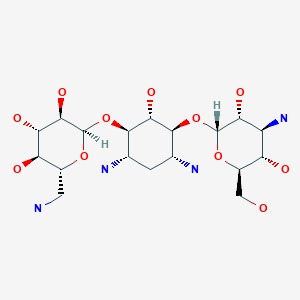Attribution Statement: LactMed is a registered trademark of the U.S. Department of Health and Human Services.
NCBI Bookshelf. A service of the National Library of Medicine, National Institutes of Health.
Drugs and Lactation Database (LactMed®) [Internet]. Bethesda (MD): National Institute of Child Health and Human Development; 2006-.
CASRN: 59-01-8

Drug Levels and Effects
Summary of Use during Lactation
If kanamycin is required by the mother, it is not a reason to discontinue breastfeeding. Kanamycin is poorly excreted into breastmilk. Newborn infants apparently absorb small amounts of other aminoglycosides, but serum levels with typical three times daily dosages are far below those attained when treating newborn infections and systemic effects of kanamycin are unlikely. Older infants would be expected to absorb even less kanamycin. Because there is little variability in the milk kanamycin levels during multiple daily dose regimens, timing breastfeeding with respect to the dose is of little or no benefit in reducing infant exposure. Data are not available with single daily dose regimens. Monitor the infant for possible effects on the gastrointestinal flora, such as diarrhea, candidiasis (e.g., thrush, diaper rash) or rarely, blood in the stool indicating possible antibiotic-associated colitis.
Drug Levels
Maternal Levels. After administration of a single 1 gram dose of kanamycin intramuscularly to several women (exact number not stated), average kanamycin milk levels were as follows: undetectable at 1 hour; 0.1 mg/L at 2 hours; 0.3 mg/L at 4 hours; and 0.5 mg/L at 6 hours after the dose.[2]
In 15 women given kanamycin 500 mg intramuscularly three times daily, average kanamycin milk levels were as follows: undetectable at 0.5 hour; 2.57 mg/L at 1 hour; 2.51 mg/L at 2 hours; 2.12 mg/L at 4 hours; 2.06 mg/L at 6 hours; and 1.6 mg/L at 8 hours after the dose.[3] Using data from this study, an exclusively breastfed infant would receive an estimated maximum daily dosage of 386 mcg/kg with this maternal dosage regimen.
Infant Levels. Relevant published information was not found as of the revision date.
Effects in Breastfed Infants
Kanamycin was used as part of a six-drug regimen to treat a pregnant woman with multidrug-resistant tuberculosis during the first trimester of pregnancy and postpartum. The infant was breastfed (extent and duration not stated). At age 1.8 years, the child had failure to thrive, possibly due to tuberculosis contracted after birth, but was otherwise developing normally.[4]
Effects on Lactation and Breastmilk
Relevant published information was not found as of the revision date.
References
- 1.
- Chyo N, Sunada H, Nohara S. Clinical studies of kanamycin applied in the field of obstetrics and gynecology. Asian Med J. 1962;5:265-75.
- 2.
- Matsuda S. Transfer of antibiotics into maternal milk. Biol Res Pregnancy Perinatol. 1984;5:57-60. [PubMed: 6743732]
- 3.
- Amiraslanova LA, Emel'ianova AI, Fursova SA, Rukhadze TG. [Various characteristics of the pharmacokinetics of ampicillin, kanamycin and cefuroxime in puerperants with endometritis]. Akush Ginekol (Mosk). 1985 Oct;(10):14-7. [PubMed: 2934996]
- 4.
- Drobac PC, del Castillo H, Sweetland A et al. Treatment of multidrug-resistant tuberculosis during pregnancy: long-term follow-up of 6 children with intrauterine exposure to second-line agents. Clin Infect Dis. 2005;40:1689-92. [PubMed: 15889370]
Substance Identification
Substance Name
Kanamycin
CAS Registry Number
59-01-8
Drug Class
- Breast Feeding
- Anti-Infective Agents
- Antibacterial Agents
- Aminoglycosides
Disclaimer: Information presented in this database is not meant as a substitute for professional judgment. You should consult your healthcare provider for breastfeeding advice related to your particular situation. The U.S. government does not warrant or assume any liability or responsibility for the accuracy or completeness of the information on this Site.
- User and Medical Advice Disclaimer
- Drugs and Lactation Database (LactMed) - Record Format
- LactMed - Database Creation and Peer Review Process
- Fact Sheet. Drugs and Lactation Database (LactMed)
- Drugs and Lactation Database (LactMed) - Glossary
- LactMed Selected References
- Drugs and Lactation Database (LactMed) - About Dietary Supplements
- Breastfeeding Links
- PubChem SubstanceRelated PubChem Substances
- PubMedLinks to PubMed
- Review Amikacin.[Drugs and Lactation Database (...]Review Amikacin.. Drugs and Lactation Database (LactMed®). 2006
- Review Tobramycin.[Drugs and Lactation Database (...]Review Tobramycin.. Drugs and Lactation Database (LactMed®). 2006
- Review Streptomycin.[Drugs and Lactation Database (...]Review Streptomycin.. Drugs and Lactation Database (LactMed®). 2006
- Review Gentamicin.[Drugs and Lactation Database (...]Review Gentamicin.. Drugs and Lactation Database (LactMed®). 2006
- Review Paromomycin.[Drugs and Lactation Database (...]Review Paromomycin.. Drugs and Lactation Database (LactMed®). 2006
- Kanamycin - Drugs and Lactation Database (LactMed®)Kanamycin - Drugs and Lactation Database (LactMed®)
Your browsing activity is empty.
Activity recording is turned off.
See more...
